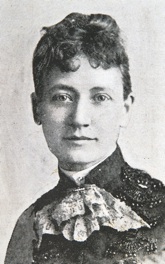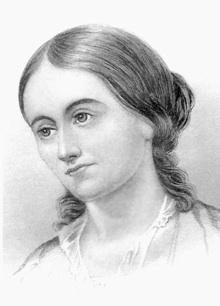
Ossoli Circle
Our Founder
Lizzie Crozier French
1851-1926
On May 7, 1851, in Knoxville, Tennessee, a daughter was born to Mary Williams and Col. John Harvey Crozier in the Crozier’s family home. On July 2, 1851, she was christened Margaret Elizabeth Crozier at Saint John’s Episcopal Church. Her mother was a homemaker; her father was a lawyer and a former US Congressman who was known to be “an orator of uncommon brilliance.”
The Crozier home housed the finest library in the city of Knoxville, and Lizzie and her four brothers and three sisters spent a great deal of time reading there. Ambrose Burnside, himself an enthusiastic reader, picked the book-lined Crozier house as his personal headquarters for three months during the Civil War. General Grant also spent a week in the Crozier home.
Lizzie was formally educated at the Covenant of Visitation School in Georgetown, D. C. and at the Episcopal Female Institute in Columbia, Tennessee.
Her husband, William Baxter French, was born in Knoxville on December 31, 1848 and was the great grandson of James White, the founder of Knoxville. Lizzie and William were married at First Presbyterian Church in Knoxville, Tennessee May 7, 1872. Their only child, William Williams French was born September 5, 1873. After celebrating only nineteen months of marriage, on December 29, 1873, Lizzie’s husband, died leaving her a widow with a young son less than four months old to raise by herself.
She was a devoted mother and loved teaching William all the necessary lessons of life. Lizzie once said that the accomplishment that she was most proud of in her entire lifetime was raising William to manhood.
Lizzie was very active in the Women’s National Party, which was the only “true” feminist organization in the United States during the interwar period. The WNP fought for equal political, legal and economic issues. It was as a suffragist that Mrs. French listed her occupation. She traveled the hills and valleys of East Tennessee lobbying lawmakers for their vote before they convened in a special session in August 1920 to consider the 19th amendment. She was persuasive and had the power to compel her ideas in such a way that she inspired others to work with the same fervor. She influenced Harry Burn’s mother to convince Harry to vote YES as he cast the deciding vote for the 19th Amendment to the Constitution of the United States giving women the right to vote.
While studying in New York, Mrs. Lizzie Crozier French, visited the Sorosis Woman’s Club, which was organized as a literary and book study club in 1868. This visit inspired her to organize a literary or reading club in Knoxville that was similar to the Sorosis Club and invited 25 ladies together for this purpose on Friday afternoon, November 20, 1885.
Ossoli Circle is fortunate to have the first minute book of the organization in its archives. Written in ink, in the firm round hand of the first secretary, Mrs. Alice G. Coffin, every word is legible. The book has been in the possession of the Circle since its founding, and so Ossoli Circle’s history is authentic in every detail.
Twelve of the twenty-five women invited, responded to Mrs. French’s call and met at Mosaic Hall of the Knoxville Female Institute which was located on the southwest corner of the present Henley and Main Streets. Mrs. French was the principal of the institute at the time.
Officers elected at the first meeting: Miss Mary Boyce Temple, a Vassar graduate, President; Miss Louise Woodruff, vice-president; Miss Cynthia Boyd, treasurer; and Mrs. Alice G. Coffin, secretary. The other charter members were also among the most prominent and educated women of Knoxville: Mrs. French, Mrs. Matthew McClung, Mrs. E. S. McClung, Mrs. Samuel McKinney, Mrs. S. G. Cooke, Miss Lucy Crozier, Miss Sadie Boyd, Miss Hattie Park, and Miss Maggie Gaines.
At that first gathering the custom of weekly meetings on Monday was established and has not been changed throughout the years. No dues were charged that first year, but an initiation fee of twenty-five cents was set. Fines were to be imposed at twenty-five cents for non-performance of duties, and ten cents for absence from meetings without just cause.
At the second meeting seven more members joined, and at the third meeting the group voted to name their circle “Ossoli” at the suggestion of Miss Mary Boyce Temple in honor of Margaret Fuller Ossoli, who was the writer, lecturer, and editor who planted the club idea in the hearts of American women. The club was named “circle” by Miss Temple, rather than “club,” because “circle” was the customary name used for women’s gatherings at that time.
In 1889 the Sorosis Club invited representatives from women’s clubs across America to come to New York for the purpose of exploring the formation of a General Federation of Women’s Clubs. Mrs. French was selected to be Ossoli Circle’s representative and it was with great pleasure that she participated in this organizational meeting of GFWC making Ossoli Circle a charter member.
Mrs. Samuel McKinney and Miss Mary Boyce Temple were two of the sixty-one delegates who attended the ratification convention in 1890, and Miss Temple was elected the first corresponding secretary of GFWC, giving signal honor to the South, to Knoxville, and to Ossoli Circle, the South’s oldest federated women’s club.
The formation of GFWC was a conscientious effort to bring all club women together for the first time to share common goals, continue their education, and provide an opportunity for them to speak in public. Through unification they were able to reach their goals more effectively.
In 1896 Ossoli Circle issued the “call” for the organization of the Tennessee Federation of Women’s Clubs.
From a limited membership of sixty-five, then seventy-five, and then one hundred, Ossoli Circle grew into a departmental club of unlimited membership.
For several years the activities of the club were almost entirely literary and social, but in 1901 Ossoli began her aid to mountain schoolwork. Since that time Ossoli Circle’s interest in welfare work has broadened to include social, economic, educational, and civic activities.
Ossoli Circle meeting places: Mosaic Hall, rented rooms on Church Street, the old Woman’s Building, and Cable Hall. In 1917 Ossoli and several other women’s organizations purchased the Lyceum Building located on the corner of Cumberland and Walnut Avenue. They met there until it was sold to the U.S. Government in 1930 for the purpose of building a main post office in downtown Knoxville. The next two years the Circle met at the Andrew Johnson Hotel.
Ossoli Circle’s Silver Anniversary was celebrated on November 21, 1910 with a “sit-down” luncheon of 200 members and guests.
On November 30, 1933, Ossoli Circle’s dream became a reality as members gathered for the first regular meeting in their new clubhouse at 2511 Kingston Pike. The devoted Building Committee were as follows: Mrs. Wiley Morgan, Chairman, Mrs. E. L. Bowman, Mrs. S.W. Duggan, Mrs. W. F. Link, Mrs. Fred Post, Sr., Mrs. Edwin B. Powers, Mrs. Neal B. Spahr, and Mrs. J. Walter Wright.
The Circle celebrated its Golden Anniversary on November 18, 1935.
At the opening session, on October 6, 1952, Mrs. Thomas H. Berry presented the Circle a life-sized bust of Sarah Margaret Fuller Ossoli, in memory of her mother, Mrs. Hugh Lawson McClung, a longtime member of Ossoli Circle. This beautiful antique statuary is located in the hall alcove beside the foyer as a reminder of the leadership of the 19th century feminist, for whom the circle was named.
Ossoli Circle celebrated its Diamond Anniversary, November 21, 1960. This year was marked by a gala Founder’s Day and the publication of a 268 page chronological history of Ossoli Circle, compiled by Mrs. E. L. Bowman. (A second volume of Ossoli Circle history up to the centennial year, was published in 1985.)
In 1965, the Diamond Jubilee of GFWC was celebrated with an evening “Open House” at Ossoli Circle’s 80th at our clubhouse. Eight Ossoli Circle delegates attended the GFWC convention in Chicago, in June 1966 to help celebrate.
Our Centennial celebration began with an Open House, October 13, 1985, with area, state and national dignitaries attending. On Presidents’ Day, December 9, 1985, the official Ossoli Circle flag was dedicated and a Time Capsule that included a U.S. Treasury Zero Coupon Bond, courtesy of Ossoli Circle members, was buried and matured in 2010. Ossoli Circle celebrated its 125th anniversary on November 22, 2010, with a special program at the club house including the GFWC International President Carlene Garner and the GFWC Southeastern Region President Jane Carver.
For the Knoxville News Sentinel 125th Anniversary in 2012, a special edition included articles on the events and citizens that impacted this region when the newspaper was founded in 1890. Read the special article on Lizzie Crozier French
Our Namesake

Margaret Fuller Ossoli
May 23, 1810 – July 19, 1850
Noble in heart and mind,
Eloquent of tongue and pen,
She was an inspiration to those
Of her own time
And her uplifting influence
Abides with us.
~ Julia Ward Howe ~
Margaret Fuller was the foremost literary woman in America in the first half of the nineteenth century. She was a teacher, writer, editor, critic, social leader, philanthropist, gifted conversationalist, organizer of new literary movements, nurse and, above all, a womanly woman.
She was the editor of the Dial, a paper advocating the development of American literary excellence. In this enterprise she was associated with Emerson, Hawthorne, Thoreau and many other well-known men of letters.
Later she was an editorial writer for the New York Tribune under Horace Greeley. Her literary “Conversations” in Boston attracted wide attention and made her famous. Margaret Fuller Ossoli was the woman who first planted the club idea in the hearts of American women when she organized in Boston, in 1839, groups of women to study literature, art and allied subjects.
She was in Italy at the time of the struggle for independence and aided the revolutionists. There she married the Marquis Giovanni Ossoli, and there, her child was born.
On the return voyage to this country, the ship in which they were passengers wrecked off Long Island, and she, her husband and son were drowned.
Enthusiasm for the highest and best animated her whole life. Genius was stamped on all she did, thought and wrote. She deserves, and has won, a lasting place in the hearts of her countrymen.
“Reverence the highest; have patience with the lowest; let this day’s performance of the meanest duty be thy religion.” ~ Margaret Fuller Ossoli

